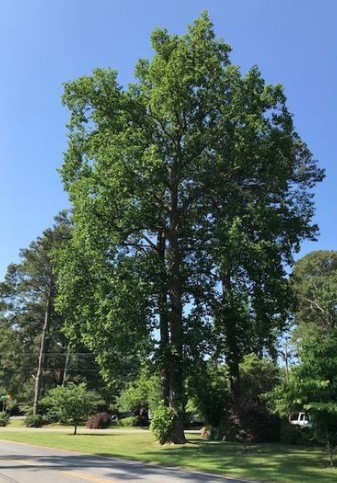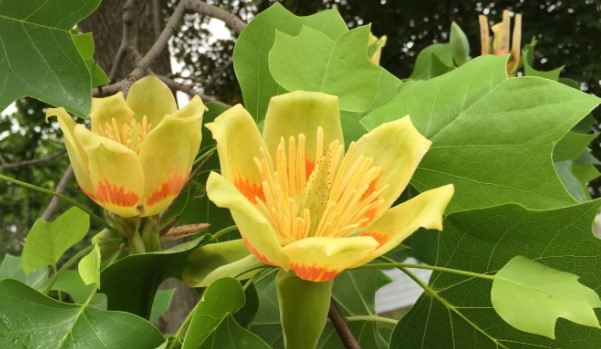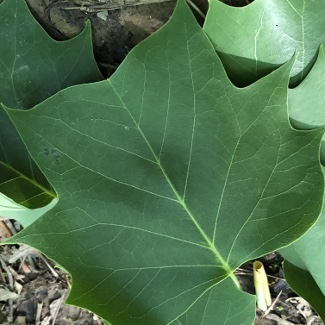Contents:
Common Names | Parts Usually Used | Plant(s) & Culture | Where Found | Medicinal Properties
Legends, Myths and Stories | Uses | Resource Links | Bibliography
Scientific Names

- Liriodendron tulipifera
- Magnoliaceae family
Common Names
- Canoe Wood
- Lyre Tree
- Old Wife’s Shirt
- Saddle Tree
- Tulip Tree
- Yellow Poplar
- Yellow Wood
Parts Usually Used
The bark
Back to Top

Description of Plant(s) and Culture
One of the tallest and most distinct in the eastern woodland, tulip poplars grow to heights of 120 feet (or more) with straight limb-less trunks until they reach a narrow crown. Large 2 inch orange, green, and yellow cup-shaped flowers appear in mid spring (in middle to north Georgia) resembling tulips flowers. The leaves are quite unusual in appearance, nearly square (4 to 6 inches long) with 4 to 6 paired lobes on long stalks which wave in the slightest breeze
Back to Top
Where Found
Eastern U.S. in deciduous woods.
Back to Top
Medicinal Properties
Antimalarial, antibacterial, antiplasmodial, tonic, stimulant and febrifuge
Back to Top
Legends, Myths and Stories

The seeds of the tulip polar are eaten by quails, purple finches, rabbits, gray squirrels, and white-footed mice.
The tulip tree is the state tree of Indiana, Kentucky and Tennessee and can trace its lineage back to the time of the dinosaurs, according to newly published research by an Indiana University paleobotanist and a Russian botanist.
A new study noted that wild populations of American ginseng could benefit from being planted near tulip poplar. The data stated that new strategies need to be pursued in conservation efforts to save the rare American ginseng plant.
- Fire Craft ~ Wood for friction fire, inner bark for tinder, hot, quick burning firewood which does not produce long-lasting coals like other hardwoods.
- Cordage ~ Inner bark fibers can be processed into cordage and rope.
- Containers ~ Outer bark crafted into berry baskets, arrow quivers, and larger pack baskets.
- Carving ~ The soft hardwood lends itself to easy carving of spoons, bowls, pottery paddles, canoe paddles, and even the canoe itself. One common name of this tree is Canoe Wood.
- Insulation ~ Shredded inner bark can be stuffed between layers of clothing to create dead air space to retain body heat in a survival situation.
- Roofing/Siding ~ Outer bark slabs used for shingles and siding on shelters.
During the United States Civil War, when the confederate troop’s quinine supplies were limited, army surgeons turned to the tulip poplar as a substitute.
During World War II, a U.S. government-directed program focused on developing quinine replacements confirmed that a crude extract of the tulip tree bark was effective in treating avian malaria.
Back to Top
Uses
Recent research studies have shown that the tulip poplar is effective as an antibacterial agent. It has been shown to fight these drug-resistant bacteria: Acinetobacter baumannii, Staphylococcus aureus, and Klebsiella pneumoniae. Researchers continue to look into the antibacterial properties of this plant.
Tulip Tree’s inner bark and leaves were used medicinally by the Cherokee and settlers in Appalachia for treating:
- Poultice from leaves for inflammation and sores.
- Inner bark tea for periodic fevers, diarrhea, pinworms, as a digestive aid and for rheumatic pain.
- Supposedly, inner bark was chewed as an aphrodisiac.
- The bark could also serve as a substitute for quinine in treating malaria.
- Tooth aches.
- Used as a tonic to induce perspiration to treat fevers.
- Root bark and seeds useful as a wormer for the body.
- Cough syrup from bark.
Tulip poplar has also been called canoe tree because Native Americans used it to make dugouts.
Tulip Tree blooms are an abundant source of nectar for honey bees which produces a dark, amber honey loaded with antioxidants.
Yellow poplar is an extremely versatile wood with a multitude of uses. Most important recent uses of the wood have been for lumber for unexposed furniture parts and core stock, rotary-cut veneer for use as crossbands in construction of furniture parts, in plywood for backs and interior parts, and as pulpwood. Considerable attention is being given to its use as structural framing material and for veneers in structural plywood as a substitute for increasingly scarce softwoods.
The bark of the tulip tree was used by Native Americans as a tonic, stimulant and febrifuge, and likely was used to treat malaria.
Tulip poplar is often used as an ornamental tree for parks and gardens where there is adequate space to accommodate its large size.
Back to Top
Resource Links
Civil War Era Medicinals Found Potentially Effective
Futurity: 3 Plants from U.S. Civil War Medical Guide Fight Infection
Emory University: Civil War plant medicines blast drug-resistant bacteria
Southern Herbalist: Tulip Poplar Medicine (Liriodendron tulipifera)
Wikipedia: Liriodendron tulipifera
Ancient ancestor of tulip tree line identified
ZME Science: Medicinal plants used in the Civil War can stomp our modern antibiotic-resistant germs
Survival Sherpa: Medicinal Uses of Tulip Poplar
University of Kentucky: Tulip Poplar
Bibliography
![]() Resources of the Southern Fields and Forests, Medical, Economical, and Agricultural; Being Also a Medical Botany of the Confederate States, by Francis Peyre Porcher
Resources of the Southern Fields and Forests, Medical, Economical, and Agricultural; Being Also a Medical Botany of the Confederate States, by Francis Peyre Porcher
![]() Wild Plants and Survival Lore: Secrets of the Forest, by Mark Warren
Wild Plants and Survival Lore: Secrets of the Forest, by Mark Warren
